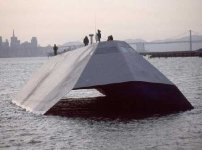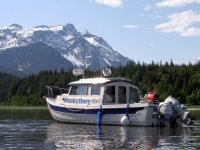journey on
New member
- Joined
- Mar 3, 2005
- Messages
- 3,599
- Reaction score
- 0
- C Dory Year
- 2005
- C Dory Model
- 25 Cruiser
- Hull Identification Number
- TBD
- Vessel Name
- journey on
Actually the way a radar works is pretty simple. It sends a beam of energy out, some of that energy is reflected back, and the time of flight is measured and there you have it, distance. Implementing that is complicated, though.
Well, a radar transmits RF energy from its antenna, which is designed to aim that energy in as tight a beam as possible. That is the only energy the radar has to work with. The only energy the receiver will see is that which is transmitted from that radar and reflected back via some conducting target, (typical boat radar, I don't speak for the whole DoD world.) Think of a mirror reflecting a flashlight beam.
This electric field energy is measured like the surface of an expanding bubble, in watts/sq. cm. And this bubble surface keeps expanding as the distance increases, which means the watts/sq. cm decreases as the square of the distance increases, because we're dealing with the bubble surface, not the radius.
Now as the electric field travels away from the radar antenna, objects get in its way and if it's a conducting surface reflects the energy equal to its surface perpendicular to the travel of the radar pulse electric field. This is the MAXIMUM it can reflect. That's the total signal the radar receiver gets back at its antenna. Of course, the return energy has some expanding surface, but to provide an upper bound, let's say all the reflected energy gets back to the radar.
For a perfect 1 sq. ft. reflector, that reflected energy is the total energy that hits the target and is reflected. It's in the microwatt range, and I'm impressed how well radar works.
So, whatever the type of reflector, it can't catch and reflect the radar's transmitted power outside of it's cross-sectional area. So if its maximum dimension is a 1' diameter, it can't reflect the same power as an object with 2 or 3 sq. ft. of area. It's physically impossible.
And, yes corner reflectors can turn a signal around. That's because the angle of the two reflecting surfaces always equal 180 deg. And the energy ALWAYS has to be reflected 180 deg, cause that's where the radar is. But it can't reflect energy that's outside it's projected cross-section. And If you turn a iron sheet edge on to the radar, it will not reflect any signal back. I feel that a large iron ship will reflect more that 1 sq. ft. worth of energy, is all I'm saying.
So, I don't know how a small reflector can reflect as much energy as something much bigger, unless the bigger thing is turned sideways. And that can always happen, but I don't think it's relevant to this discussion. All we're trying to do is set an UPPER bound on the reflected energy.
As far as transponders go, they create their own energy and thus amplify the radar's signal. One can find that on sea bouys, which actually provide their location and name. I'm not aware of any in my price range, but they do have them for aircraft.
Sea clutter is reflected energy from the ocean surface, and is treated as noise. Modern radars try to filter it out, based on it's random properties. But I agree it's noise, and the target signal need to be picked out from that. However, it has nothing to do with the amount of energy a reflector reflects.
Again, I wouldn't count on a small radar reflector letting that tanker or ferry being able to see you in the sea clutter, and then avoid you. A Furuno 1623 LCD Radar is 1300 bucks, let's you see the danger and take corrective action. If you operate in fog or at night, it's the best saftey device you can have. Oh, that and your depth sounder.
That's all, Folks
Boris
Well, a radar transmits RF energy from its antenna, which is designed to aim that energy in as tight a beam as possible. That is the only energy the radar has to work with. The only energy the receiver will see is that which is transmitted from that radar and reflected back via some conducting target, (typical boat radar, I don't speak for the whole DoD world.) Think of a mirror reflecting a flashlight beam.
This electric field energy is measured like the surface of an expanding bubble, in watts/sq. cm. And this bubble surface keeps expanding as the distance increases, which means the watts/sq. cm decreases as the square of the distance increases, because we're dealing with the bubble surface, not the radius.
Now as the electric field travels away from the radar antenna, objects get in its way and if it's a conducting surface reflects the energy equal to its surface perpendicular to the travel of the radar pulse electric field. This is the MAXIMUM it can reflect. That's the total signal the radar receiver gets back at its antenna. Of course, the return energy has some expanding surface, but to provide an upper bound, let's say all the reflected energy gets back to the radar.
For a perfect 1 sq. ft. reflector, that reflected energy is the total energy that hits the target and is reflected. It's in the microwatt range, and I'm impressed how well radar works.
So, whatever the type of reflector, it can't catch and reflect the radar's transmitted power outside of it's cross-sectional area. So if its maximum dimension is a 1' diameter, it can't reflect the same power as an object with 2 or 3 sq. ft. of area. It's physically impossible.
And, yes corner reflectors can turn a signal around. That's because the angle of the two reflecting surfaces always equal 180 deg. And the energy ALWAYS has to be reflected 180 deg, cause that's where the radar is. But it can't reflect energy that's outside it's projected cross-section. And If you turn a iron sheet edge on to the radar, it will not reflect any signal back. I feel that a large iron ship will reflect more that 1 sq. ft. worth of energy, is all I'm saying.
So, I don't know how a small reflector can reflect as much energy as something much bigger, unless the bigger thing is turned sideways. And that can always happen, but I don't think it's relevant to this discussion. All we're trying to do is set an UPPER bound on the reflected energy.
As far as transponders go, they create their own energy and thus amplify the radar's signal. One can find that on sea bouys, which actually provide their location and name. I'm not aware of any in my price range, but they do have them for aircraft.
Sea clutter is reflected energy from the ocean surface, and is treated as noise. Modern radars try to filter it out, based on it's random properties. But I agree it's noise, and the target signal need to be picked out from that. However, it has nothing to do with the amount of energy a reflector reflects.
Again, I wouldn't count on a small radar reflector letting that tanker or ferry being able to see you in the sea clutter, and then avoid you. A Furuno 1623 LCD Radar is 1300 bucks, let's you see the danger and take corrective action. If you operate in fog or at night, it's the best saftey device you can have. Oh, that and your depth sounder.
That's all, Folks
Boris


